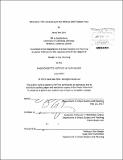Waiting for TOD : developing in the Millbrae BART Station Area
Author(s)
Shih, Janet Wei
DownloadFull printable version (32.55Mb)
Alternative title
Waiting for transit-oriented development
Developing in the Millbrae BART Station Area
Developing in the Millbrae Bay Area Rapid Transit Station Area
Other Contributors
Massachusetts Institute of Technology. Dept. of Urban Studies and Planning.
Advisor
P. Christopher Zegras.
Terms of use
Metadata
Show full item recordAbstract
The suburban terminus station dedicates large amounts of land for parking in order to cater to its driving riders, and causes a trade-off tension between attracting ridership through providing park-and-rides and building transit-oriented development (TOD) within station areas. I focus my research on the Millbrae Intermodal Station, a suburban terminus station in the Bay Area Rapid Transit (BART) system, which is still waiting for a large amount of TOD to occur in its station area. The predominant research question for this thesis is: What are the challenges of creating TOD at suburban terminus stations and how can mixed use, highdensity, and human-scaled environments be better facilitated to become a reality? To answer this question, I took a mixed methods approach that included (1) evaluating ridership and parking supply data of all BART stations, (2) analyzing the primary and contextual case studies by comparing TOD plan documents to the current build-out reality of each station's station area, (3) conducting focused interviews with experts to gain insight on the barriers to implementing TOD at the Millbrae Station, and (4) developing a design proposition of how the Millbrae Station Area could engage alternative uses on its station parking lots. For all of the evaluated stations, parcels immediately approximate to the station had more difficulty realizing TOD than parcels further away from the station. Issues that surfaced as barriers to TOD included weak market conditions, land assemblage, construction costs, parking replacement standards, existing parcel ownership, and existing land use. In addition, TOD plans at more mature stations took an extensive period of time to become realized. To demonstrate how this inevitable waiting period could be more productive, I conclude by proposing design interventions and a strategy for how Millbrae, in the meantime, could apply and experiment with temporary flexible uses on its station parking lots.
Description
Thesis (M.C.P.)--Massachusetts Institute of Technology, Dept. of Urban Studies and Planning, 2012. Cataloged from PDF version of thesis. Includes bibliographical references (p. 128-133).
Date issued
2012Department
Massachusetts Institute of Technology. Department of Urban Studies and PlanningPublisher
Massachusetts Institute of Technology
Keywords
Urban Studies and Planning.